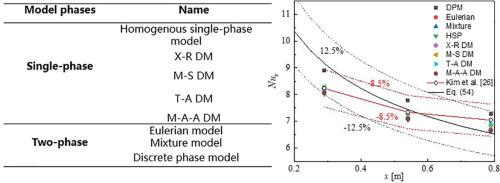Advanced Powder Technology ( IF 4.2 ) Pub Date : 2020-06-23 , DOI: 10.1016/j.apt.2020.05.032 Zhaoping Ying , Boshu He , Di He , Yucheng Kuang , Jie Ren , Bo Song

|
This paper numerically studies Al2O3/water nanofluids that convectively flow inside the laminar regime of a tube with a constant wall heat flux with various models. Eight different models are utilized to predict the heat transfer behavior of the nanofluids, and the predictions are compared with the available experimental data from literature and the values of the conventional correlation. Comparisons show that all eight models are suitable for the prediction of Al2O3 nanofluids with relatively small particle concentrations (0.25 wt% and 0.5 wt%, mass fractions) of Al2O3/water, within the maximum deviation between the predictions of all models and corresponding experimental data less than 20%. While comparison results with experiments of relatively large particle concentrations (0.6%, 1.0% and 1.6%, volume fractions) show that Mixture model overestimates the heat transfer performance. Discrete phase model increases the prediction accuracy about 10% for two-phase models and agrees well with the classical Shah Equation within the maximum error of 5.5%. The error of Nusselt number between the predictions of discrete phase model and experimental data falls off with the increase of Reynolds numbers and axial direction position. The discrete phase model, Xuan-Roetzel dispersion model, and Talieh-Abbas dispersion model are precise approaches to predict the laminar convectional heat transfer behavior of Al2O3/water nanofluids in the scope of 0–1.6% nanoparticles. The Xuan-Roetzel dispersion model and Talieh-Abbas dispersion model are suggested for applications where the calibration data are available.
中文翻译:

Al 2 O 3 /水纳米流体对流换热数值预测的单相和两相模型比较
本文对各种模式的Al 2 O 3 /水纳米流体进行了数值研究,这些流体对流在具有恒定壁热通量的管的层流状态下流动。利用八个不同的模型来预测纳米流体的传热行为,并将预测结果与文献中的可用实验数据以及常规相关值进行比较。比较表明,所有八个模型都适用于预测具有相对较小的颗粒浓度(0.25 wt%和0.5 wt%,质量分数)的Al 2 O 3的Al 2 O 3纳米流体。/水,所有模型的预测值与相应的实验数据之间的最大偏差应小于20%。虽然与较大颗粒浓度(0.6%,1.0%和1.6%,体积分数)的实验的比较结果表明,Mixture模型高估了传热性能。离散相模型将两相模型的预测精度提高了约10%,并且在5.5%的最大误差内与经典Shah方程非常吻合。随着雷诺数和轴向位置的增加,离散相模型的预测值与实验数据之间的努塞尔数误差减小。离散相模型,Xuan-Roetzel弥散模型和Talieh-Abbas弥散模型是预测Al层流对流传热行为的精确方法2 O 3 /水纳米流体在0-1.6%的纳米颗粒范围内。建议将Xuan-Roetzel色散模型和Talieh-Abbas色散模型用于可获得校准数据的应用。







































 京公网安备 11010802027423号
京公网安备 11010802027423号